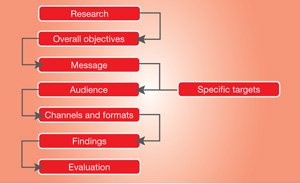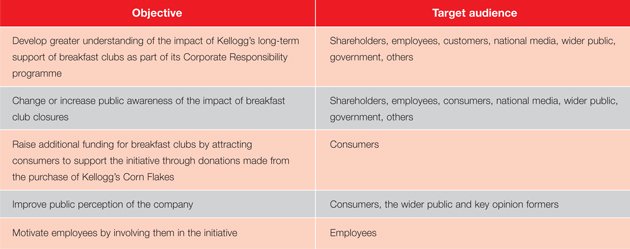
Research shows that children benefit from eating a healthy breakfast prior to the start of the school day. However, too often children have no breakfast at all or eat chocolate or crisps and a fizzy drink on their way to school.
This case study examines how Kellogg’s devised a plan to communicate the importance of breakfast to selected target audiences through a multi-platform campaign. This was in support of its ‘Help give a child a breakfast’ campaign launched in October 2011.
Kellogg’s is the world’s leading producer of cereals. Its products are manufactured in 18 countries and sold in more than 180 countries. Kellogg’s produces some of the world’s most easily recognisable brands such as Kellogg’s Corn Flakes, Coco Pops and Rice Krispies. For more than 100 years, Kellogg’s has been a leader in health and nutrition by providing consumers with a wide variety of food products.
Breakfast clubs

Kellogg’s has been active in supporting breakfast clubs in schools for many years, working with the education charity ContinYou, the experts on breakfast clubs. Breakfast clubs provide a healthy meal at the start of the day in a safe and friendly environment. They also provide a great opportunity for kids to play, learn and socialise with classmates.
Since 1998, this partnership has set up 500 breakfast clubs in schools across the UK. Interested schools have been supported with training on how to start a club and have received a start-up grant from Kellogg’s.
According to research by Kellogg’s, many schools have run into trouble with the funding of their breakfast club due to recent budget cuts by the UK government. Kellogg’s responded by putting a team together to create a communications plan which highlighted the importance of breakfast clubs to parents, schools, the UK government and the public.
Writing a communications plan

The communication process involves transmitting information from a sender to a receiver. However, effective communication needs to ensure that the message has been not only received but also clearly understood. This is relevant whether the communication is internal or external. The message needs to be sent in a way that it will appeal to and be understood easily by the target receiver or audience. This involves selecting an appropriate format or channel to deliver the message.
Examples of media that may be used include a leaflet, a television advert and a personal letter. The feedback part of the process is vital as this is how the sender knows if the message has been received correctly.

For the message to be effective, barriers to communication (known as ‘noise’) need to be eliminated or reduced. Noise is anything that might distort the message or prevent the receiver from getting or understanding the message. For example, noise might include using language or jargon that the receiver will not understand or using a channel such as an email or the internet when the receiver does not have a computer.
Tailoring the message

A communications plan uses the same principles of tailoring the message and the delivery channel for a target audience. A communications plan also sets out the overall objectives to be achieved and the means by which these will be measured.
Businesses engage in both internal and external communication. Internal communication may involve transmitting messages to shareholders, senior managers, other employees or contractors. Communication externally may be to a range of stakeholders including customers, suppliers, the media, government or the wider public. In each case, the nature of the message and the format used may be tailored to suit the audience. An effective internal communications plan can help to give clear direction within the organisation and improve employee motivation. Externally, it can even change public opinion.
Background and purpose

Research commissioned by Kellogg’s showed that as many as 1 in 7 children in the UK do not eat breakfast and that up to 25% eat crisps, chocolate or fast food on the way to school. In addition, 1 in every 8 (around 3,000) breakfast clubs in the UK have closed due to government budget cuts and up to 45% of remaining clubs were at risk of closure.
Research with teachers showed that the majority believe that the lack of breakfast opportunities would lead to poorer academic results and worsening behaviour in schools. The purpose of Kellogg’s campaign was to show its commitment to breakfast clubs in schools in the UK. The important messages that the campaign was aiming to get across were that:
- breakfast is important for people of all ages especially young people
- breakfast clubs positively impact on children’s behaviour, attendance and ability to concentrate in morning lessons
- Kellogg’s has supported breakfast clubs since 1998
- by buying Kellogg’s Corn Flakes you are helping to feed children at breakfast clubs.
Kellogg’s faced potential noise for its messages from different sources. At the time, the government spending review was high profile in the press which could have resulted in Kellogg’s story being overlooked. In addition, other food companies also support breakfast clubs which could have led to confusion or dilution of its messages.

It also needed to make clear that this was not a marketing effort to promote Kellogg’s brands but a part of the company’s longstanding Corporate Responsibility programme. Corporate Responsibility involves understanding the impact the business has on the wider community and working to make that impact positive. Kellogg’s has been supporting breakfast clubs in schools and local communities for 14 years and has invested over £1.5 million to date.
Fitting the message to the audience

Kellogg’s breakfast club campaign had a number of key objectives which depended on promoting the right messages to different audiences. Key aspects of the campaign were not only to get messages across about the benefits of breakfast and breakfast clubs but also to raise funds for the clubs through the sale of Kellogg’s products and to make schools aware of the available funding from Kellogg’s to support their breakfast clubs.
In order to achieve these objectives, Kellogg’s devised a communication plan for internal and external stakeholders. The main internal stakeholders being targeted were Kellogg’s employees. They were encouraged to get involved through information posted on the company intranet (internal communication). Employees were also invited to attend a breakfast club in the atrium of the Kellogg’s building with two local primary schools and then visit breakfast clubs that received funding from Kellogg’s.
However, the campaign was primarily designed for the needs of external audiences. These included:
- Schools – to alert them to the Kellogg’s grants available, inviting them to apply for funding.
- The media – to generate excitement and press interest about the campaign and to increase public awareness of the issues involved.
- Parents – to demonstrate Kellogg’s socially responsible stance and inform them how breakfast clubs could support their children.
- Members of Parliament (MPs) – asking them to encourage schools in their constituencies (i.e. the area that they had been voted to represent) to apply for funding.
- The public – to attract consumers to buy Kellogg’s products in order to generate additional funding for the breakfast club initiative.
Using the right medium
In order to convey any message effectively to a targeted audience, the most suitable medium and channel need to be used. For example, if a company wants to promote products with a mass-market appeal to a wide audience, it might use well-scripted television advertising. To advertise a job opportunity for a finance director of a company, a business might place an advertisement in the Financial Times (or other financial and business-related publications).

Take, for example, the message that ‘Kellogg’s supports breakfast clubs’. How should Kellogg’s communicate this message to children and parents? Kellogg’s approach was to use a multiplatform campaign. This is an approach that communicates over a range of media, rather than using just one, in order to reach many different audiences.
The various campaign communications involved a mixture of formal and informal communications. Formal communications are through approved channels and so might include, for example, a company policy document or a press release. Kellogg’s formal communications included the letters sent to MPs.

In contrast, informal communication is more spontaneous and less structured, for example, a chat with colleagues over coffee. Informal communication can be very effective in a business as it has the advantage of being quicker and more direct. Kellogg’s face-to-face interactions at breakfast clubs and the briefing to mummy bloggers demonstrated a more informal approach to communication. The problem with informal communication is that it could result in rumours that can cause messages to be mistrusted or even convey inaccurate information.
Conclusion

Breakfast clubs provide a healthy meal at the start of the day in a safe and friendly environment. They also provide a great opportunity for kids to play, learn and socialise with classmates. Kellogg’s has long supported breakfast clubs and so planned a multi-platform approach to communicate key messages about the importance of breakfast and breakfast clubs to various audiences. The feedback to any communication is important to evaluate whether your messages are reaching the target audience effectively. Kellogg’s, therefore, carried out an evaluation of its campaign. Highlights include:
- The first six weeks of the campaign generated 73 press articles across a variety of media – including news coverage on ITV’s Daybreak and news articles in The Observer and The Independent. All carried positive reaction to the messages and reached a potential audience of nine million people.
- Over 700 schools applied for the funding and around 500 of these received a grant of up to £450 for their breakfast club.
- Kellogg’s employees have attended 15 of those breakfast clubs with the local MP to see what difference the funding has made to the children.
- The money raised from the campaign will provide a million breakfasts by the end of 2012.

These results clearly indicate that Kellogg’s has communicated its messages effectively. The time taken in planning the communications through a multi-platform approach worked in relation to each of the targeted audiences. As a food company that takes its responsibility for nutrition seriously, Kellogg’s has maintained its commitment to write to and talk to key government officials to get the message over about the importance of breakfast for children. This highlights how effective communication is not just a one-off event but an ongoing cycle requiring evaluation and response to feedback received.
Kellogg’s | Devising a communications plan
About this case study:
This case study examines how Kellogg’s devised a plan to communicate the importance of breakfast to selected target audiences through a multi-platform campaign. This was in support of its ‘Help give a child a breakfast’ campaign launched in October 2011.
Click HERE to download this case study »




